Posts by jim
“SharedAirDFW” is DFW’s New Regional Air Quality Monitoring Network
Monitors are being assembled.
Software is being written.
Community meetings are happening.
Downwinders is helping build the region’s
first 21st-Century Air Network
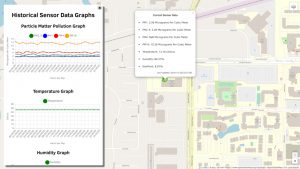
The first images from the mapping app UTD students are building for the new SharedAirDFW Air Quality Monitoring Network. Here data is being received by monitors already installed on the UTD campus. Residents will be able not only to see current conditions but levels over the last 24 hours or more.
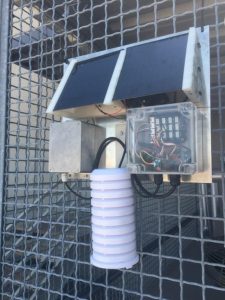
One of the over 100 new SharedAirDFW air quality monitors being built in the UTD laboratory that will be distributed throughout DFW, including Joppa, West Dallas, Southern Dallas, and Midlothian.
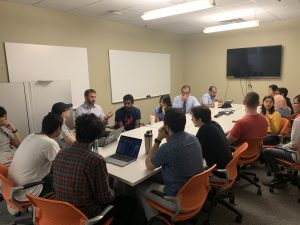
UTD students working with Downiwnders’ consultant Robert “the map” Mundinger on the SharedAirDFW mapping app software and interface.
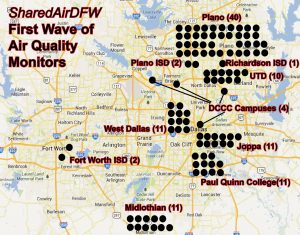
By this time next year the Network plans on having over its first 100 air quality monitors distributed throughout DFW, including the “front line” communities of Joppa, West Dallas, Southern Dallas and Midlothian.
____________________________________
Real Time Air Quality Information is Coming to DFW
It’s taken years of work and a lot of patience but with any luck a new citizen-friendly regional air monitoring network will debut in 2020.
Under the working title of “SharedAirDFW” over 100 new custom-built air quality monitors are being distributed throughout the DFW region in the next 12 months that will be able to give residents real time information about the air they breathe for the first time. When it’s up and running, it’ll be the first network of its kind in Texas and one of the largest in the U.S.
Based out of the University of Texas at Dallas laboratories and fueled by its graduate students, as well as Downwinders’ grant monies, these monitors will offer real time information through a easily accessible app.
Right now a handful of official EPA monitors provide air quality readings up to one or two hours behind real time conditions. SharedAirDFW willl increase the number of calibrated air quality monitors in DFW by a factor of four while giving readings updated every few seconds.
Almost half of the new monitors are going to front line communities in the DFW area: 33 monitors purchased by Downwinders are going to Joppa, West Dallas, and Midlothian, while another 11 purchased by Paul Quinn College are slated for the Southern Dallas neighborhoods surrounding its campus.
Joppa residents will get a preview of the system at a December 5th community roll out involving UT researchers, Habitat for Humanity, Paul Quinn, and local elected officials. Community events in Midlothian and West Dallas will follow.
This is one of the most important projects Downwiders has helped birth in its 25 year history. We’ll be bringing you updates as we get closer to bringing the whole system online. Thanks for you support.
Listen to Our New Chair Get Interviewed By D Magazine
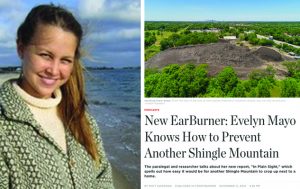
Downwinders at Risk’s new Chair Evelyn Mayo gets a huge shout out in D magazine’s popular online manifestation with her very own “Earburner” podcast.
D magazine reporter Matt Goodman and D Managing Editor Tim Rogers interview Evy about her new report on Southern Dallas zoning for Legal Aid, her Roller Derby years in Singapore, and of course, Particulate Matter.
CLICK HERE to link to the podcast and learn more about one the new dynamic leaders of Downwinders at Risk.
The Only Thing Missing in Dallas’ Climate Plan “Focus on Equity” is…any measure of Equity
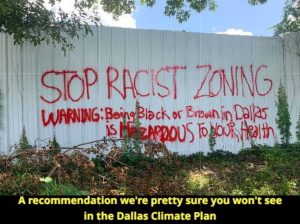
A staff presentation focusing on Dallas environmental equity lacks any metrics for comparing residential pollution burdens, or even for measuring the success of its own outreach effort.
So how does City Hall know what environmental “equity” looks like?
According to management guru Peter Drucker, “If you can’t measure it, you can’t improve it.”
Then what does it mean that a full year into a Dallas climate planning process heavily touted as reflecting the city’s emphasis on “equity” there’s still no map showing how pollution burdens are distributed across Big D? And what does it tell you when a presentation meant to advertise the inclusiveness of the City’s outreach effort for its climate plan doesn’t document participation by residents of color?
It tells you that despite all the rhetoric on the subject, Dallas City Hall isn’t serious about environmental justice yet.
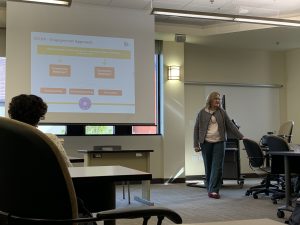
Office of Environmental Quality and Sustainability Susan Alvarez presents the City’s climate plan through “an equity lens.”
Exhibit A: “Dallas’ Climate Action Through an Equity Lens.” 



This was a presentation that Susan Alvarez, Assistant Director of the City of Dallas Office of Environmental Quality & Sustainability, gave as part of Eastfield College’s Sustainability as a Social Justice Practice: Developing Resilient Strategies held last Friday, November 8th.
Context is everything and so it’s important to note that the entire thrust of both the Conference and the City’s specific presentation was aimed squarely at how to respond to current environmental challenges in an equitable and just way. Here was a chance for Dallas OEQS city staff to display their embrace of equity as it relates to the climate plan it’s been paying a half-million dollars to consultants to construct. It was their very own EJ report card.
Equity and the Climate Plan:
And sure enough, there was no turning away from Dallas’ racist history in Alvarez’ presentation. Maps showing the City’s chronic segregation and poverty were included, as well as allusions to the Trinity River as the city’s dividing line between Haves and Have-Nots. Alvarez spoke about the current “Redlining Dallas” exhibit at City Hall that traces the City’s history of racism across 50 feet of photographs and stories.
In fact, just about every impact of the City’s official segregation was referenced, except for the one you’d expect.
There was not a single slide or sentence expended on the disproportional environmental impacts of 100 years or more of Dallas racism. No maps of where heavy industry zoning is allowed in the City. No maps of where most of the City’s largest polluters are located. No maps of what zip codes or Council Districts have the highest pollution per capita numbers. No references to past environmental justice struggles with the City like the West Dallas RSR fight, or gas drilling.
Watching the presentation you’d get the impression that racism infected every aspect of life for Dallas residents of color except for their exposure to pollution. But of course, we know that’s not true.
During this and other presentations on the climate plan-in-progress, staff go out of their way to point out that industry makes up “only 8% of emissions.” But if you’re interested in applying “equity” to this number the next slide should show the audience where that industry is distributed in Dallas – a map showing you where industrial polluters are allowed to set-up shop. A slide to show you the amounts of permitted pollution by Zip Code, or maybe actual 2017-18 emissions by Council District. But there is no next slide.
If there were, it would show that most of that industry is located in predominantly Black and Brown neighborhoods. Racist zoning is at the heart of not just banking, education, and employment inequities in Dallas. It also means the dirtiest industries have always been located in close proximity to people who were institutionally considered Second-Class citizens.
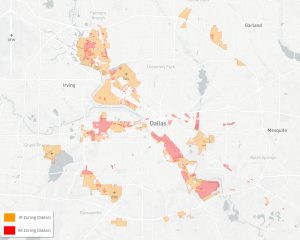
This one slide is already more information on Dallas environmental equity than you’ll find in the entire City staff presentation on equity and the climate plan
Disproportional exposure to industrial pollution by residents of color is not just AN equity issue. It’s THE single most important equity issue when you’re speaking about environmental justice in Dallas. The City’s Black and Brown residents are more likely to be exposed to harmful pollution than their white peers because the City’s own zoning designed it that way – but you’d never know it watching this presentation, on equity, at the social justice conference.
The “Redlining Dallas” exhibit that Alvarez cited thinks so. Along with other insidious effects of racism, it gives space to the RSR clean-up fight Luis Sepulveda and his West Dallas Coalition for Environmental Justice waged in the early 1990’s. But there was no mention of that fight or any other Dallas examples during the presentation on equity, at the social justice conference.
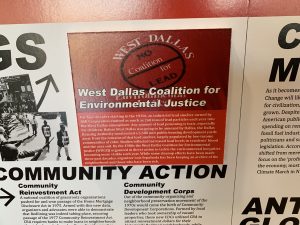
Staff referenced every other kind of red-lining on display at the City Hall exhibit – except the one most relevant to the topic.
Nor was there any mention of how much industry was located in the Trinity River floodplain, doing business in Black and Brown neighborhoods founded because the City wouldn’t allow these so-called “undesirables” to live anywhere else but side by side with “undesirable” industries. Alvarez made the point in the presentation that climate change means more flooding in general and more severe flooding. The next slide should show who and what is affected by that new flooding risk. A slide showing what percentage of heavy industry is located in the flood plain. A slide showing what the racial make-up and income levels are of those who’ll be more affected by increased flooding…and contamination. But there was no next slide, in the presentation on equity, at the social justice conference.
If you don’t have accurate maps of the inequities plaguing the status quo, how do you know when or if you’re ever getting rid of them? How do you judge success without a baseline?
PR, Process and Equity:“I don’t think it’s important to say I’ve got four black people in my stakeholders group.”
Alvarez lowered expectations for the presentation by saying it would only look at the question of equity in how it was applied to the City’s climate plan “community engagement.” No actual equity policy options from other plans were on the table, just how well the plan’s public relations campaign did.
Not very well, she admitted. In fact the initial meetings and publicity were so anemic that she said the professional PR folks at Earth X had a come-to-Jesus-meeting with staff about a reboot. So that’s tens of thousands of dollars wasted on PR consultants only to be usurped by better free advice from locals.
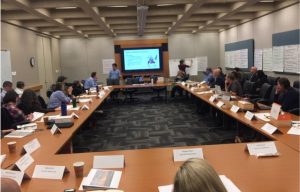
A meeting of the Dallas climate plan advisory group.
In her recounting of the climate plan’s PR rollout and planning process Alvarez gave an overview of the mechanics. “X” number of meetings attracted “X” numbers of people. The City’s survey got “X” number of responses. An “X” number of people serve on an advisory stakeholders group.
Considering the very specific circumstances of the presentation, the next slide should have been how the results of those attending meetings, or completing a surveys, or advisory committee memberships reflect Dallas’ population as a whole. How do we stack up to who we’re representing? According to the Statistical Atlas Dallas is approximately 25% Black, 41% Hispanic , 30% White and 3% Asian. So the next slide should compare what percentage of those attending climate plan meetings, or completing surveys, or becoming advisory committee members were Dallas residents of color vs the city demographics.
But there was no next slide about how inclusive the City’s climate plan community outreach or advisory process has been in the presentation on equity, at the social justice conference.
In response to a question about the lack of such information Alvarez said it was irrelevant to the topic at hand. “I don’t think it’s important to say I’ve got four black people in my stakeholders group.”
Since the advisory group membership is only listed online by organizational affiliation it’s impossible for anyone outside the meetings to know what the ethnic or gender make-up of it is. There are 39 separate entities listed. 25% of that number would be nine to ten black people.
In elaborating, Alvarez challenged the idea that mapping Dallas’ racial or ethnic disparities in pollution  burdens was necessary to understanding “Dallas’ Climate Action Through an Equity Lens.” She more or less stated it didn’t matter. (the presentation was recorded by Eastfield College and Downwinders has asked for access to it in order to quote Alvarez accurately).
burdens was necessary to understanding “Dallas’ Climate Action Through an Equity Lens.” She more or less stated it didn’t matter. (the presentation was recorded by Eastfield College and Downwinders has asked for access to it in order to quote Alvarez accurately).
Nothing could better summarize the kind of Catch-22 “don’t confuse me with the facts” approach to “equity” the City staff has taken in regards to environmental racism than the belief that actual data about Dallas environmental racism is of no use to the study or remedying of Dallas’ environmental racism.
And nothing makes a better case for the need to pass environmental justice reforms the Southern Sector Rising Campaign is advocating at Dallas City Hall, including an environmental justice provision in Dallas’ economic development policy, restoration of the Environmental Health Commission, and creation of a Joppa Environmental Preservation District. If residents want environmental equity considered in city policy they’re going to have to enlist their City Council members, do it themselves, and enact reforms like these.
The same is true as City Hall ramps up to take on citywide land-use planning in its “forwardDallas!” process early next year. When staff recently released the City’s “equity indicators” report, there was an indicator for everything but the environment. It only reinforced the idea that the environment, and environmental justice, are still after-thoughts in Dallas city government. Residents will have to arm themselves with the information the City staff can’t or won’t provide. They should start with the recent Legal Aid report “In Plain Sight” that demonstrates deep neglect for code and zoning regulations in Southern Dallas.
And it also goes for the climate plan. Southern Sector Rising’s first recommendation for the city’s climate plan last May was “Remove industrial hazards from the flood plain.” On the other hand, the idea of land use reforms in the floodplain hasn’t appeared in any official literature or presentation associated with the city’s climate plan.
Grist recently published an article about the Providence Rhode Island climate planning process that looks to be the exact opposite of the model Dallas has adopted. But that city benefited from having an environmental justice infrastructure already in place when the climate crisis assignment arrived. Where’s the home for Environmental Justice in Dallas City Hall? Right now, it’s with staff that doesn’t think metrics about equity are important, in its presentation on equity, at the social justice conference.
The Only Public Hearing in the Nation on the Trump EPA Rollback of Methane Emission Rules for Oil and Gas is in Dallas: 8am to 6pm Thursday October 17th
 October 17th is also the date of the only public hearing being offered on one of the most far-reaching rule-rollbacks of the Trump administration – allowing more methane to be released from the nation’s oil and gas wells. And it’s right here in Dallas.
October 17th is also the date of the only public hearing being offered on one of the most far-reaching rule-rollbacks of the Trump administration – allowing more methane to be released from the nation’s oil and gas wells. And it’s right here in Dallas.
In August, the Trump EPA officially proposed its rollback of the methane emissions regulation put in place by the Obama administration. This one-day hearing in Dallas is the single chance for citizens to speak-up and be heard in person. You can bet industry will be out in force to support it.
As many of you already know, Methane pollution is less plentiful than CO2 but is approximately 85 times more potent as a climate destroyer. This is part of what makes it so important to decrease emissions.
But Methane is also a surrogate pollutant for a host of chemicals called VOCs – Volatile Organic Compounds – like the carcinogen Benzene. When you decrease methane emissions from an oil or gas well, you’re also decreasing VOC emissions across the board.
Many VOCs are dangerous toxins and as a class of chemicals contribute to smog. Downwinders at Risk landmark 2015 study of smog sources in DFW identified 50 tons a day of VOCs from regional gas wells and production facilities that contributed up to almost 4 parts per billion of smog.
 Rolling back the Obama Administration rule to limit methane emissions means more toxic exposures to thousands of residents in DFW living within hundreds of feet of wells and facilities. it also means our chronic, three-decade old smog problem, which got worse this summer for the first time in five years, will keep going further south.
Rolling back the Obama Administration rule to limit methane emissions means more toxic exposures to thousands of residents in DFW living within hundreds of feet of wells and facilities. it also means our chronic, three-decade old smog problem, which got worse this summer for the first time in five years, will keep going further south. It’s no coincidence that these hearings take place during working hours when professional lobbyists can attend but working people can’t. Nevertheless DFW residents must step up and represent all those folks from around the US who are not being given a chance to speak.
The public hearing will be held at the Earle Cabell Federal Courthouse, 1100 Commerce Street, in Dallas, in the Red River and Live Oak conference rooms on the 7th floor. According to the official notice, “Because this hearing is being held at a U.S. government facility, individuals planning to attend the hearing should be prepared to show valid picture identification to the security staff to gain access to the meeting room.”
To register to speak, you have to use the online registration form available at https://www.epa.gov/controlling-air-pollution-oil-and-natural-gas-industry/proposed-policy-amendments-2012-and-2016-new or contact Virginia Hunt at (919) 541-0832 to register to speak. The last day to pre-register to speak at the hearing will be October 14, 2019.
Testify downtown and then come and hear Dr. Bullard testify at Paul Quinn.
Dr. Robert Bullard in Dallas Oct 17th at Paul Quinn to Unveil New Report
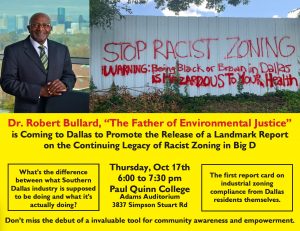
Environmental Justice issues in Dallas will get a higher profile next week as the “Father of Environmental Justice” comes back to Big D to help promote the release of a new landmark report on zoning in Southern Dallas.
 Texas Southern University’s Dr. Robert Bullard is no stranger to DFW, having included a chapter on the struggle to get the West Dallas RSR lead smelter Superfund Site cleaned-up in his 1994 book “Unequal Protection.” But it was 1990’s “Dumping on Dixie” that’s widely recognized as the very first comprehensive look at what he termed “environmental racism” in the US – how rural Southern communities of color became national dumping grounds.
Texas Southern University’s Dr. Robert Bullard is no stranger to DFW, having included a chapter on the struggle to get the West Dallas RSR lead smelter Superfund Site cleaned-up in his 1994 book “Unequal Protection.” But it was 1990’s “Dumping on Dixie” that’s widely recognized as the very first comprehensive look at what he termed “environmental racism” in the US – how rural Southern communities of color became national dumping grounds.
Dr. Bullard returns to Dallas on Thursday October 17th for a full day of appointments and visits concluding with a presentation that evening at Paul Quinn College of a new Legal Aid of Northwest Texas report on the continuing impact of racist land use policy in Dallas’ “Southern Sector.”
Entitled “In Plain Sight” this Legal Aid effort is a blockbuster.
It’s the first close-up look at industrial zoning in Southern Dallas, comparing what’s on the books versus what’s actually taking place on-site. And it’s Dallas residents themselves who did the investigation, with teams of unofficial neighborhood inspectors visiting each site, taking pictures, and recording observations. In effect, it’s a citizen report card on the City’s enforcement of its own land use policies in the most neglected, abused parts of Dallas.
Inspired by the example of the now notorious Shingle Mountain illegal dump, which was allowed to operate by the City of Dallas without either the correct Certificate of Occupancy or the correct zoning, the study finds there are plenty of other examples of this kind of “non-compliance” throughout Southern Dallas. In fact, violation rates were found to be extremely high in some neighborhoods. It’s Exhibit A for why there must be systematic zoning reform in Dallas.
There are lots of events happening on the17th, but you really don’t want to miss the roll-out of this important, game-changing report and a chance to meet and talk to a living legend.

Marsha Jackson standing in her backyard
Update: A 21st Century Regional Air Monitoring Network for DFW is On Its Way
 me technical and bureaucratic hitches, momentum is starting to build toward the 2020 operation of a true 21st Century DFW regional air quality monitoring network.
me technical and bureaucratic hitches, momentum is starting to build toward the 2020 operation of a true 21st Century DFW regional air quality monitoring network.
A small army of University of Texas at Dallas graduate students are assembling over 100 solar-powered wireless air monitoring units to be dispersed throughout the metro area. A third of those have been purchased by Downwinders for placement in Joppa, West Dallas, and Midlothian. 40 or more or going to Plano. Three Dallas County Community College campuses are receiving one, along with the Fort Worth and Richardson school districts.
And now news has come that Paul Quinn College has received an EPA grant to purchase 11 of these monitors for placement around its Southern Dallas campus. Downwinders is working to coordinate the location of its Joppa area monitors with Paul Quinn to provide Southern Dallas with its own mini-network of monitors.
Meanwhile another group of UTD students are working on the mapping software and app residents will be able to use to access the data in real time. They’re being led in this effort by Robert “The Map” Mundinger, who Downwinders hired for the job. All in all, Downwinders has now invested almost $50,000 in this network, which we hope will become a model for the rest of Texas and the nation.
LafargeHolcim is a “Conscientious Corporate Citizen” Everywhere But Texas

In Europe, LafargeHolcim is a multinational cement manufacturer based in Switzerland and France – two countries on the cutting edge of climate crisis planning and members of the progressive European Union. The Company portrays itself as a climate-conscientious corporate citizen, to the point of its Swiss CEO declaring the reduction of CO2 emissions as his first, most important priority.
In Midlothian Texas, LafargeHolcim runs the most conventionally dirty cement plant in Texas and is seeking a permit that could make it one of the most climate-hostile one as well. In fact, there’s some reason to believe the Holcim plant in North Texas is preparing to burn by-products from either the Canadian Tar Sands, the Permian Oil Field, or both, as fuel.
Baking rock to make cement takes a lot of heat. Regardless of how new or old a cement kiln is, regardless of the pollution controls a kiln has, every cement maker in the world still has to employ the same age-old process of applying a 2000 degree open flame to a mix of limestone and other ingredients. A third or more of the cost of running a cement plant is keeping that open flame consistently hot enough to do the job.
This is the reason cement kilns will always try to find cheap, free, even profitable sources of fuel for that flame. Hazardous and industrial wastes that c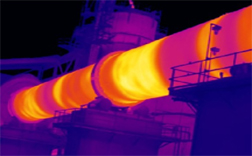 an be diverted from incinerators or landfills can be burned in cement kilns for slightly less money because they don’t have to meet the same standards. Used tires and oil. Lottery tickets. Dashboards from cars. Even municipal waste is now being burned in kilns.
an be diverted from incinerators or landfills can be burned in cement kilns for slightly less money because they don’t have to meet the same standards. Used tires and oil. Lottery tickets. Dashboards from cars. Even municipal waste is now being burned in kilns.
Burning anything causes air pollution. Burning wastes causes lots of conventional and exotic air pollution, including CO2. But just baking limestone rock also releases a lot of stored CO2. Even if there was some was to make cement without a flame, the heat needed would still release tons of CO2.
Worldwide the cement industry is estimated to be responsible for 5 to 7% of the planet’s CO2 emissions – larger then the airline industry. If the industry were a country, it would be the third largest emitter on earth, behind the United States and China.
Companies like LafargeHolcim are facing both public and financial pressures to reduce that number. In July European funds managing $2 trillion in assets called on cement companies to slash their greenhouse gas emissions, warning that a failure to do so could put their business models at risk. The mangers specifically mentioned LafargeHolcim and urged it to adopt the goal of net zero carbon emissions by 2050 and align itself with the Paris Climate Accords.
LaFarge Holcim has responded by initiating a series of technical innovations and pilot projects under the banner of “The Plant of Tomorrow” to prove its forward thinking.
Almost 300 facilities around the globe are targeted for inclusion in one or more of these “Plant of Tomorrow” projects, including a Canadian kiln installing a carbon-capture pilot project, an Ohio kiln building three wind turbines to secure its electrical needs, and kilns burning industrial waste as “low carbon” (if not low toxic) fuel.
Left out of this mix so far is Holcim’s woe-be-gone Midlothian plant. You might call it Holcim’s “Plant of Yesterday.” Despite having lots of stiff competition, Holcim not only operates the dirtiest cement plant out of the three doing business in Midlothian, but it’s the dirtiest in the entire state.
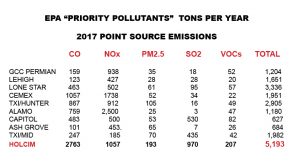
Holcim’s Midlothian plant is the largest Carbon Monoxide (CO) polluter among all 10 Texas cement plants – a sign of poor combustion. It’s the second largest Nitrogen Oxide (NOx) polluter among the bunch, emitting almost twice as much smog pollution as the other two Midlothian cement plants combined. It’s the largest PM 2.5 (Particulate Matter) polluter by far – almost 100 tons a year separate it from second place. It’s the largest Sulfur Dioxide (SO2) polluter by a large margin and releases four times as much Volatile Organic Compounds (VOCs) than the next highest plant. Almost all 2017 pollution numbers for Holcim have gone up over the last five years. A plant that was already bad is getting worse.
Now add Holcim’s request for a new permit to burn 100% Petroleum Coke in one of its two kilns.
Pet Coke is a byproduct of oil refining. It’s a concentrated carbon solid residue that is left behind after the refining process has converted the bulk of the oil into liquid fuels such as gasoline and diesel.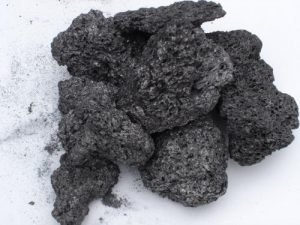
Pet Coke is like coal, but dirtier. Pet Coke looks and acts like coal, but it has even higher carbon emissions than coal. On a per-unit of energy basis Pet Coke emits 5 to 10 percent more carbon dioxide than coal. A ton of Pet Coke yields on average 53.6 percent more co2 than a ton of coal.
As well as significantly higher co2 emissions, Pet Coke also has high sulfur and toxic metals content than coal.
Because its a waste product, Pet Coke is cheap for Holcim to buy or it could even be free if a refinery wanted to get rid of its supply. And now, thanks to the exploitation of the Tar Sands and the oil boom in the Permian the US has lots and lots of Pet Coke. The heavy oil refining capacity in America is now the largest in the world, with over 40 percent of the global market. Much of that production takes place on the Texas Gulf Coast in huge new expanded refinery complexes like Motiva and Total in Port Arthur. The capacity to produce Pet Coke in U.S. refineries has doubled since 1999. In fact, the annual production of Pet Coke is so large these days, it’s outstripped most of the usual uses for it and is “priced to move.”
Because Holcim wants to burn 100% Pet Coke, and it must have a reliable source to burn it 24/7, there’s reason to believe the company has signed a sweetheart deal with one or more refineries to supply it. Probably from the Gulf Coast, and probably from one of the refineries dealing in Canadian Tar Sands oil or Permian Basin product. Both are poster boys for irresponsible fossil fuel development with the Tar Sands and the Keystone Pipeline igniting modern Climate Crisis activism and the Permian becoming one the planet’s largest sources of Methane as tons of unused natural gas are burned off from thousands of rigs.
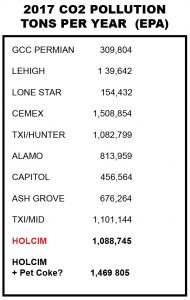 Currently, Holcim is “only” the third largest CO2 polluter among all ten cement plants in Texas, and fourth among all of Holcim’s U.S. plants. But burning 100% Pet Coke in its Kiln #2 could change that rapidly by adding a whopping 400,000 tons more of CO2 to its annual totals. That would send it to #2 in Texas and #2 in the entire US Holcim fleet of cement plants. Not very climate conscientious. And probably not a number you want to tout in trying to sell your “Plant of Tomorrow.”
Currently, Holcim is “only” the third largest CO2 polluter among all ten cement plants in Texas, and fourth among all of Holcim’s U.S. plants. But burning 100% Pet Coke in its Kiln #2 could change that rapidly by adding a whopping 400,000 tons more of CO2 to its annual totals. That would send it to #2 in Texas and #2 in the entire US Holcim fleet of cement plants. Not very climate conscientious. And probably not a number you want to tout in trying to sell your “Plant of Tomorrow.”
At the same time Holcim is trying to project an image of a concerned 21st Century corporate entity to the rest of the world, it’s doing business in Texas like its still 1999.
Officially, the State of Texas doesn’t care about CO2 pollution. Heck, officially it doesn’t even believe there’s a climate crisis. There is no regulatory system for controlling its releases and only the EPA bothers to track CO2 releases at all. So this increase in planet-melting pollution will go completely unaddressed in the permit proceedings themselves.
Also officially, despite the evidence, the State and Holcim both say no other kinds of pollution will increase when 100% Pet Coke is burned at Holcim. No increase in PM 2. 5. No increase in SO2. No increase in metals. Citizens don’t believe them. A group calling itself “Midlothian Breathes” has formed to fight the new permit and has already caught regulators off guard asking tough questions about new emissions.
But trying to get the State of Texas to do the right thing about air pollution is an uphill fight. Instead, perhaps citizens should take these embarrassing numbers directly to LafargeHolcim, who’s claims of new fund corporate responsibility are belied by them. Contrasting its Texas operations with those of the rest of its facilities may be a way to shame the company in its own European backyard. Officially the company may still be able to be embarrassed. Texas state government left that possibility behind years ago.
DFW Smog Gets Worse for First Time Since 2015. Government: ¯\_(ツ)_/¯

2019’s “ozone season” came in like a lamb but is headed out as big, wheezy lion.
A three-day stretch from Thursday September 5th to Saturday the 7th that combined triple digit temperatures with lots of air pollution was enough to push Dallas-Fort Worth smog numbers for the year over 2018’s annual average. It was the first year-to-year increase in ozone levels since 2015, and more than enough to insure DFW will be in violation of the Clean Air Act for the 28th year in a row.
Because the formula for arriving at these averages is so convoluted, discounts the highest three numbers, and is stretched out over 8-hour periods, it takes a lot ozone to make them go up even incrementally. Raising the annual average by even one part per billion (ppb), from 76 to 77, as occurred by Saturday evening, hides a lot of Really Bad Air. Smog levels were in the 90’s and even close to 100 parts per billion at monitoring sites in the northern part of the Metromess. EPA’s national standard for 8-hour exposure to ozone is a 70 ppb average.
Three sites saw their 2019 highs set during this 72 hour period. Frisco had an eight hour average of 88ppb on Saturday, Keller 84 ppb and North Dallas 83ppb. There were four hours on the afternoon of the 6th when smog was over 90 ppb in Frisco.

That’s reminiscent of the bad ‘ol days from the Turn of the Century when levels in the upper 90’s and even topping 100 ppb were routine. Since 2000, there’s been a more or less steady fall in smog in DFW thanks to better controls on combustion-powered vehicles, and the citizen-induced decreases in pollution from Midlothian cement plants and the retiring of East Texas coal-fired power plants. In 2000 DFW’s annual ozone average was 102 ppb. It’s taken 20 years to lower that number to the high-to-mid 70’s. For the last three years we’ve seen decreases of 3, 1 and 3 ppb. 2019 halts that downward trend.
Beside the human health toll these numbers represent – an increase in asthma attacks, ER visits, strokes and heart attacks. – they also represent a challenge to government. This increase comes as the usual planning process to reduce dirty air in DFW sits in tatters. In fact, there really is no process anymore.
In the past, the North Central Texas Council of Governments (NTCOG) would bring the Chambers of Commerce, elected officials and some environmentalists together to cobble out a list of proposed strategies to reduce smog, then submit it to the Texas Commission on Environmental Quality in Austin where it would get watered down by corporate lobbying. Nevertheless, those past plans did have an influence on tightening emissions for ancient cement kilns and other industrial sources and they can take some credit for the two-decade decrease in smog.
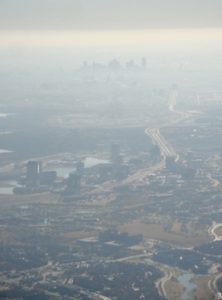
But that process hasn’t taken place since even before the current administration took office. The last plan submitted by the region to the state was in 2013. Because Austin kept ignoring most of the region’s recommendations, NTCOG just gave up trying after that. It’s Clean Air Steering Committee was disbanded and hasn’t met for six years now. Despite approaching our fourth decade of illegally bad air there’s no official body in DFW working on a regional clean air plan. Everything is being run by Greg Abbott’s state agency – one that doesn’t believe there’s a climate crisis, wants to increase permissible exposure for dangerous pollutants, and whose former Toxicologist in now leading the Trump administration’s efforts to roll back federal pollution standards.
It’s doubtful a single part per billion rise in the regional average will prompt reconsideration of this laissez-faire approach. But it should.
Before the 2016 election, Downwinders was trying to pave a path for the federal government to take away the power of Austin to determine DFW’s clean air progress. We had hoped to have EPA delegated as the “final cut” author of a new clean air plan. Trump’s election made that impossible. But should this administration be gone by 2021, that strategy is still one local residents would be wise to pursue. As long as the State’s environmental agency is in the hands of anti-science flunkies and fanatics, there will be no concern about DFW smog in Austin.
Texas Misusing 17-Year Old Rural Air Pollution Model to Permit Inner-City Joppa Asphalt Plant
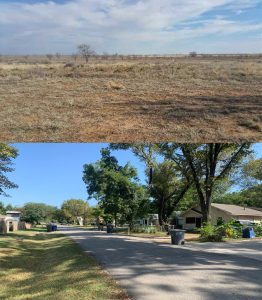
One of these is not like the other
What if you found out an industrial polluter was operating in your densely-populated neighborhood and the state told you not to worry because an obsolete computer model of the polluter’s releases 17 years ago and 500 miles away, in a desert, performed by the polluter themselves, said everything was OK?
That’s exactly the situation Joppa residents find themselves in as the Texas Commission on Environmental Quality (TCEQ) goes through the motions of renewing one of the permits of the many industrial polluters located in the community.
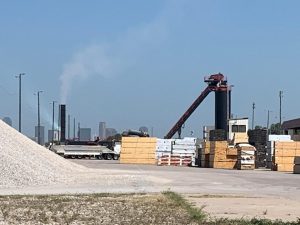 Austin Industries’ asphalt batch plant sits next to the Marietta Martin (TXI) concrete batch plant in Joppa, and both are in the Union Pacific switch yard and all of those are adjacent to the giant Tamko asphalt roofing factory.
Austin Industries’ asphalt batch plant sits next to the Marietta Martin (TXI) concrete batch plant in Joppa, and both are in the Union Pacific switch yard and all of those are adjacent to the giant Tamko asphalt roofing factory.
Austin has applied to the TCEQ for a renewal of its 10-year old air permit for its Joppa plant and gave notice last December. Legal Aid of NorthWest Texas requested a contested case hearing on behalf of the Joppa Freedman’s Town Association and Downwinders at Risk requested one on behalf of resident Jabrille McDuffie.
To absolutely no one’s surprise, TCEQ’s Executive Director recommended against such a hearing at the beginning of August in comments mailed out to all parities. He argued that contrary to the opponent’s claims there was sufficient evidence that Austin Industries permit in Joppa was following the law and was “protective of human health.” Previous “air quality analysis,” the Executive Director says, have concluded such already.
The entire basis of that “air quality analysis” is the computer air modeling performed by Austin Industries’ hired contractors and supposedly double-checked by the state…in 2002.
Just like any other computer model, it all depends on the variables: volume of air pollution, local meteorology, stack height, local “receptors” aka people or animals who live by or near the facility, and even local terrain. Winds do one thing to air pollution on the open plains and another in the middle of a city block.
Because of these variables, an Exxon refinery that wants to build a facility in Houston with the exact same design as is has in Arkansas still has to submit a separate computer model to account for the distinct surroundings in the new location. The one from Arkansas just won’t do for Houston.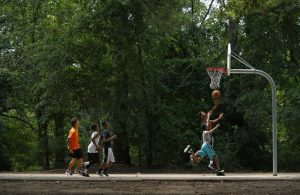
Or at least that’s the way things are supposed to work. But like so much else in Southern Dallas these days, things aren’t working the way they’re supposed to.
According to the TCEQ the Austin Asphalt facility is a portable asphalt batch plant operation. That means it wasn’t built specifically for its current Joppa site. It was moved there and it can be moved somewhere else.
In 2002 it first operated in Hockley County, a rural part of Northwest Texas near Lubbock some 400 miles west of Joppa. It moved to its current location in Joppa in 2008.
In 2002 the TCEQ let Austin Industries use what’s called a “SCREEN3” air model to determine if the air pollution from its asphalt batch plant’s was a threat to anyone in Hockley County. Again unsurprisingly, the firm hired by Austin Industries to do the computer modeling found it was “protective of human health.”
TCEQ says the Austin Industries’ asphalt plant has never been subject to any additional “impacts evaluation.” besides this 2002 review.
That means the only air modeling ever done for this Austin asphalt plant was while it was operating in rural Hockley County in 2002. There has been no air modeling of the plant since it came to Joppa in 2008.
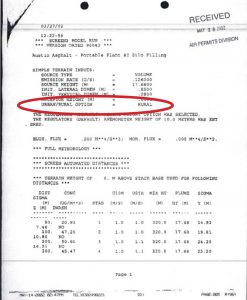
In 2002 the Austin plant was in West Texas and used a rural air model. In 2019 they’re still using for it for operation in Joppa.
Besides the most obvious and important difference in population density between unincorporated Hockley County near Lubbock and inner city Dallas, all of the variables in the 2002 modeling apply only to the Hockley County location. Meteorology, stack height, and surrounding terrain among them. In fact, the entire model was defaulted to a “rural” versus “urban” option in 2002. This renders the modeling scientifically useless in its current location in Joppa.
But that uselessness isn’t keeping the Executive Director of the Texas Commission on Environmental Quality from citing it to justify renewal of Austin’s air permit.
There’s also the matter of the age and limitations of the SCREEN3 model. In 2011 EPA replaced it with something called the “AERSCREEN” model. In doing so the agency called the old model “outdated“ and said “there are no valid reasons” to keep using SCREEN3.
And it’s not just the EPA. State environmental agencies, like the Arizona Department of Environmental Quality, have quit accepting SCREEN3 modeling.
Alex De Visscher, Associate Professor and Canada Research Chair in Air Quality and Pollution Control Engineering at the University of Calgary, writing in an 2013 text book entitled “Air Dispersion Modeling: Foundations and Applications,” said SCEEN3 is a “product of a previous generation of air dispersion modeling” and “is no longer a recommended model… it does not allow for multiple sources, and it does not include atmospheric chemistry or deposition.”
These exclusions are important. There are multiple sources of Particulate Matter 2.5 air pollution at Austin Industries’ plant in its Joppa location, including piles of raw material, and industrial combustion at the site. SCREEN 3 modeling didn’t and wouldn’t reflect these multiple sources of pollution. And of course when you’re talking about PM 2.5 pollution, as you are with an asphalt batch plant, the atmospheric chemistry and deposition, or fallout, is critical.
TCEQ’s own air modeling guidelines say so:
“Air dispersion models utilize dispersion coefficients to determine the rate of dispersion for a plume. Dispersion coefficients are influenced by factors such as land-use / land-cover (LULC), terrain, averaging period, and meteorological conditions. Evaluating the LULC within the modeling domain is an integral component to air dispersion modeling. The data obtained from a LULC analysis can be used to determine representative dispersion coefficients. The selection of representative dispersion coefficients may be as simple as selecting between rural or urban land-use types. For the ISC, ISC-PRIME, and SCREEN3 models, the dispersion coefficients are based on whether the area is predominately rural or urban. The classification of the land use in the vicinity of sources of air pollution is needed because dispersion rates differ between rural and urban areas.”
The TCEQ itself says it makes a fundamental difference whether the air model for a polluter is run for urban or rural terrain. Yet for over a decade TCEQ and Austin Asphalt have misused the results of a “rural” computer model to misleadingly assure inner-city Joppa residents that the company’s asphalt plant posed no harm.
What’s more, the modeling performed in 2002 only examined “asphalt vapors,” a made-up, vague pollutant category that can’t be monitored or measured. It didn’t examine Particulate Matter 2.5 pollution or specific Volatile Organic Compounds that make up those “vapors” and was therefore incomplete in the extreme.
So despite all the verbage the TCEQ’s Executive Director uses to tell Joppa residents th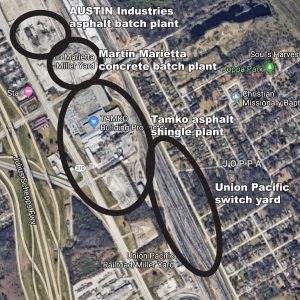 at past “air analysis” has shown Austin Industries’ plant to be protective of human health, in truth the only “analysis” ever done was performed 17 years ago in a sparsely-populated rural location 400 miles away from its current location, with what TCEQ admits are totally inaccurate modeling inputs by company consultants. It didn’t include all priority pollutants or even all sources of air pollution from the facility and the model used is now considered obsolete by EPA, modeling experts, and other state environmental agencies.
at past “air analysis” has shown Austin Industries’ plant to be protective of human health, in truth the only “analysis” ever done was performed 17 years ago in a sparsely-populated rural location 400 miles away from its current location, with what TCEQ admits are totally inaccurate modeling inputs by company consultants. It didn’t include all priority pollutants or even all sources of air pollution from the facility and the model used is now considered obsolete by EPA, modeling experts, and other state environmental agencies.
Joppa residents deserve better.
In its response to the Executive Director, Downwinders at Risk specifically requested TCEQ delay further regulatory action on this permit renewal until it can conduct a modern comprehensive air modeling impact analysis for Austin Asphalt’s current operation in Joppa that requires an evaluation of all on-site sources of pollution, including fugitive and mobile sources, on the Austin Asphalt site, off-site near-by sources of pollution within a three kilometer (1.86 mile) radius of Austin Asphalt’s facility, and representative monitored background concentrations obtained from local Joppa neighborhood monitoring as well as modeling of permitted maximums emission rates form all sources.
On September 11th the Texas Commission on Environmental Quality will take up the Austin Industries permit renewal at its headquarters in Austin. Both Legal Aid and Downwinders at Risk representatives will be present to answer any questions from the Commissioners but will not be allowed to make any statements. We’ll let you know the outcome.
One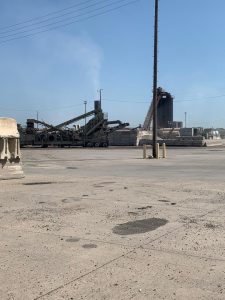 might reasonably ask why the City of Dallas itself isn’t fighting this permit renewal? After all in 2007, the city took on a string of proposed coal-fired power plants that it said would increase air pollution for Dallas. But to date that same city has never bothered to try and stop an industrial polluter from opening shop or renewing its permit in one of its most abused neighborhoods.
might reasonably ask why the City of Dallas itself isn’t fighting this permit renewal? After all in 2007, the city took on a string of proposed coal-fired power plants that it said would increase air pollution for Dallas. But to date that same city has never bothered to try and stop an industrial polluter from opening shop or renewing its permit in one of its most abused neighborhoods.
This dishonest use of a irrelevant model by the state’s discredited environmental agency shows why it’s imperative the City of Dallas – and all municipalities in Texas – change the way they do business and be proactive in addressing their environmental justice and environmental health issues in their own city limits.
Too often city representatives default to state or federal officials on the environment when they should be the first line of defense, not the last. City officials’ reliance on a failed state agency to perform its job as environmental protector is what caused Shingle Mountain. It’s what caused this situation in Joppa. To change that means changing both policies coming out of City Hall and current City Hall culture. Environmental Protection is a Do-It-Yourself proposition these days.
Downwinders Welcomes New Board Member Cindy Hua
 At our June board meeting, we welcomed Cindy Hua to membership on the Downwwinders Board.
At our June board meeting, we welcomed Cindy Hua to membership on the Downwwinders Board.
Cindy came to us via our monthly portable monitoring training, which she quickly mastered and now helps teach. She’s a SMU graduate student in Sustainability Design with a BA in Biology and committed to bridging STEAM education and environmental justice.
Her work is focused on building STEAM experiences that foster creativity and confidence to empower all people to create positive social and environmental change.
Cindy is already a central part of our continuing education program, and she’s looking forward to building partnerships with local schools and universities to educate students to address environmental issues within their community.
Beginning this fall we’re taking the portable training that attracted Cindy to our ranks out on the road to teach folks in their own groups and settings. We’re also drafting up a more formal relationship with area colleges for our technology lending library. Cindy will be in the middle of all this. We’re very grateful she’s joined our board and look forward to working with her.
